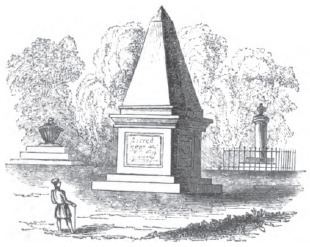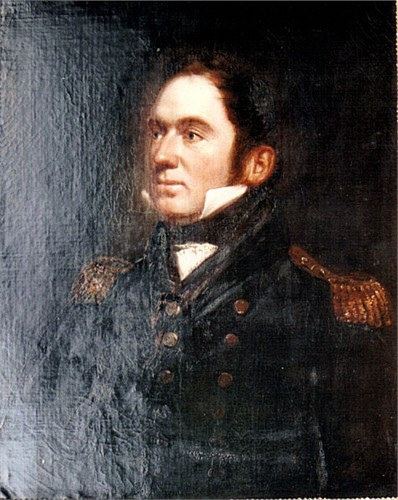Died June 13, 1841 Name Humphrey Senhouse | ||
 | ||
Awards Knight Commander of the Hanoverian Guelphic Order,Companion of the Most Honourable Military Order of the Bath Similar People Guan Tianpei, James Bremer, Lindsay Tasman Ride, George Chinnery, Robert Morrison | ||
Captain Sir Humphrey Fleming Senhouse, KCH, CB (baptised 6 June 1781 – 13 June 1841), was a British Royal Navy officer. He served in the Napoleonic Wars, War of 1812, and First Anglo-Chinese War. In China, he commanded HMS Blenheim, in which he died in Hong Kong from fever contracted during the British capture of Canton.
Contents

Early life
Senhouse was born in Barbados and baptised there on 6 June 1781. He was the third son of William Senhouse (1741–1800) and his wife Elizabeth. His father was a lieutenant in the Royal Navy, and surveyor-general of Barbados and the Leeward Islands. His mother was daughter of Samson Wood, the speaker of the Barbados Assembly. His grandfather, Humphrey Senhouse of Netherhall, Cumberland, married Mary, daughter and co-heiress of Sir George Fleming, bishop of Carlisle.
Senhouse joined the navy in January 1797 on board HMS Prince of Wales, the flagship of Rear-Admiral Henry Harvey in the West Indies Station. In November 1797, he moved to the brig Requin, in which he arrived in England for the first time in 1799. From March 1800 to April 1802, he served in HMS Fisgard under Captains Thomas Byam Martin and Michael Seymour.
Mediterranean and North America
On 7 April 1802, Senhouse passed his examination, and was promoted as lieutenant of HMS Galgo two days later. In May 1803, he was appointed to HMS Conqueror with Captain Thomas Louis. With Israel Pellew, who relieved Louis in April 1804, Senhouse served in the Mediterranean, West Indies, and in the Battle of Trafalgar, until January 1806. He again went to the West Indies on board HMS Elephant, and was put on board the flagship of HMS Northumberland under Sir Alexander Cochrane. In September 1806, he was appointed to command HMS Express on the Spanish Main and Leeward Islands until March 1808, when he joined HMS Belleisle as a flag-lieutenant to Cochrane, who sent him home with despatches in July 1808 in HMS Subtle.
On 26 January 1809, Senhouse rejoined Cochrane, now in command of HMS Neptune. After assisting in the debarkation of troops in the invasion of Martinique, he was promoted on 7 March to HMS Wolverine, which he commanded in the West Indies until the following December. There, he also commanded HMS Ringdove and HMS Superieure. He was promoted to commander on 2 June. From 1810 to 1812, Senhouse commanded HMS Recruit at Gibraltar, Newfoundland, and the Halifax Station. He then commanded the 18-gun sloop HMS Martin from 1812 to 1814 in the Halifax Station.
In the War of 1812 against the United States, he defended the Martin, aground in Delaware Bay, against a flotilla of eight gunboats and two blockships on 29 July 1813. He made prize of the 6-gun privateer Snap Dragon containing 80 men, assisted in the capture of Moose Island, and was sent home with despatches by Cochrane, announcing the success of the expedition in Castine, Maine. He was promoted to post-captain on 12 October 1814, and from April to September 1815, commanded HMS Superb on the coast of France as flag-captain to Sir Henry Hotham. From 25 February 1831 to 1834, he served in HMS St Vincent, most of the time as flag-captain to Vice-Admiral Hotham, commander-in-chief of the Mediterranean Station. King William IV told Hotham at Windsor:
Sir Henry, you are most fortunate in having one of the cleverest fellows of the navy for your Captain. [...] Yes, I am sure I need not tell you so; he must be not only a clever man, but most zealous in his profession; few like him would have employed the leisure the peace has given him in gaining the information he has; there was not a question I asked him that he could not give me a ready and satisfactory reply. [...] You are lucky in having him.
In July 1831, British warships in the Mediterranean observed smoke caused by the emergence of a volcanic island between Pantelleria and Malta. After being detached in the cutter Hind to ascertain its exact position, Senhouse landed on the island on 3 August, where he planted the Union Jack and named it Graham Island. He was nominated a Knight Commander of the Hanoverian Guelphic Order on 13 April 1832, and made a Knight Bachelor on 5 June 1834.
China
On 9 April 1839, Senhouse commissioned HMS Blenheim. He was sent from England to fill the office of second-in-command of British naval forces in China, where he served in the First Anglo-Chinese War. Commodore James Bremer, commander-in-chief of British forces, entrusted the attack on Anunghoy Island to Senhouse in the capture of the Bogue forts on 26 February 1841. After the Blenheim fired broadsides from starboard at the island's fort, Senhouse landed with about 300 marines and seamen to clear the few remaining defenders. On 31 March, Bremer sailed to Calcutta in the steamer Queen to confer with Lord Auckland about the state of affairs and request reinforcements, leaving Senhouse in command of the naval forces.
On 13 June 1841, Senhouse died on board the Blenheim in Hong Kong from fever contracted during the operations in Canton in May 1841. As the next senior naval officer, Captain Thomas Herbert took over command of the ship and fleet. Duncan MacPherson of the Madras Army wrote, "On the morning of the 13th of June, when it was announced to him [Senhouse] that all hopes of saving his life was at an end, he immediately directed that the signal be made for all captains of H. M.'s ships to repair on board; but ere the first had arrived, our gallant commodore was a corpse." Before he died, he wished to be interred in Macao because of uncertainty about Hong Kong's future as a British settlement. The steamship Nemesis arrived with his body in Macao on 16 June. The next morning, a funeral procession began from Captain Charles Elliot's house. Major-General Hugh Gough, Captain Herbert, Deputy Superintendent of Trade Alexander Johnston, at least 70 military officers, and nearly all the British and foreign residents were in attendance. Also present was the Portuguese governor of Macau, his band who played the funeral march, and a contingent of Portuguese troops who fired three volleys over his grave at the Old Protestant Cemetery. On 29 June, Senhouse was nominated a Companion of the Most Honourable Military Order of the Bath. A bell that he captured in the Bogue forts was sent to England by Captain John Charles Pitman in HMS Druid. It was donated to St Mary's Church in Gosforth by Senhouse's widow in 1844.
Family
In 1810, Senhouse married Elizabeth, daughter of Vice-Admiral John Manley. She died on 1 March 1865, aged 81. They had two daughters:
After the death of his brother James Lowther Senhouse, he purchased the manor of Seascale from his family. He also built the mansion called Seascale, later renamed Steelfield. Note that Parker (as cited) is incorrect as he had predeceased his brother by 3 years (Revd James Lowther Senhouse died at Sawley, Derbyshire on 5 September 1844). He actually purchased it after the death of his mother in 1834/1835.
